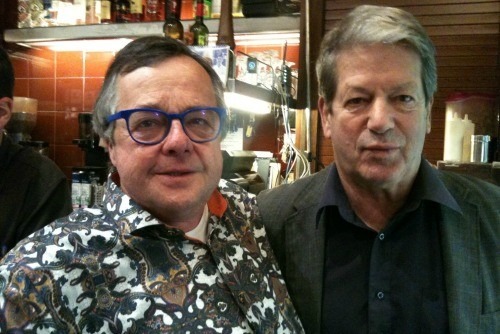Cal Pep In Barcelona: As On-Fire As Ever!
Trends come and go, Michelin stars wax and wane, but Cal Pep, a slender tapas counter tucked away on the eastern edge of the Born-Ribera, still ranks in the forefront of Barcelona's finest dining experiences. (We also ranked it No. 86 for best restaurants in Europe for 2014, and the No. 3 best in Barcelona in 2015).
Few of the world's top food destinations can offer the quality and spontaneity available at this 20-stool bar that cognoscenti learn is well worth the wait. As with the Boqueria's Pinotxo, it's only partly about the food. Pep Manubens and his generosity of spirit, his absolutely universal and democratic mirth and good cheer, his (and his staff's) apparent ongoing love affair with all comers, be they from Tokyo or Timbuktu: all of these factors contribute. Barmen can be spotted leaning across the counter to shake hands with or embrace departing clients, and in some 40 years of Cal Pep encounters I can't remember a single unhappy customer.
At first glance, a diner in a hurry might conclude that the place is too crowded to bother with and, to be sure, if you're not happy with a 20-40-minute stand-up happy hour while waiting your turn, this might not be the place for you. But the rewards are, well, rewarding.
First, you meet clued-in and unpretentious people from all over the world. Cal Pep has probably been more written about than any place in Barcelona (unless it's Pinotxo), and savvy souls from all of the round Earth's imagined corners show up here prepared to wait their turn and try the classic Cal Pep specialties: the slipper bread with oil and tomato squeezings; spinach and garbanzo beans with bacon and black sausage; the so-called (four-cornered) "trifásico" of tiny fried sole, whitebait, shrimp, and calamari; the foie-gras sausage in a Port reduction; and a few dozen other perfectly prepared morsels. Beyond these small portions to share there is grass-fed beef or the über-fresh catch-of-the-day (which Pep loves to hold up in his fingers and wiggle as a demonstration of their just-out-of-the-Mediterranean quality).
Pep Manubens (left) and author at Cal Pep
But what is it about Cal Pep that makes every visit there euphoric? OK, the copious quantities of good wine pouring down your neck while you wait helps; a freezing crisp albariño or verdejo goes down swimmingly after a good trek through Barcelona. The flaming grill about three arms'-lengths away looks, feels, sounds, smells, and eventually tastes wonderful, so the sensorial rush is comprehensive, along with the easy hanging-out-in-the-kitchen comfort factor that chef's tables have long understood and addressed.
In fact, comfort may be the key factor at Cal Pep. What is Pep's signature garbanzo-spinach-bacon dish other than comfort food? And, for that matter, why is "comfort food" so frequently relegated to the rumpus room of gastronomical endeavor? How many times have you heard chefs of Michelin-starred restaurants vowing to "leave it all behind" and open a simple bistro devoted to his or her grandmother's favorite recipes?
Ferran Adrià, at his iconic elBulli, was officially credited with doing away with the menu and the classic appetizer, first course, second course, dessert format established by minstrel and style-setter Ziryab in ninth-century Córdoba, but Pep may have beaten him to the punch by years. Cal Pep orders develop randomly in brief consultations with barmen whose English is up to the task. A variety of small portions meant to be shared arrive in timely fashion and carefully staggered to fit limited space on the counter. A menu is rarely — if ever — seen. Progression from greens (pimientos de Padrón or spinach or deep-fried artichokes) to marisco (shell fish and crustaceans) to fin fish, sausage or beef may or may not be observed, depending on the client's preferences and the waiter's advice.
Any way you slice it, though, the fare chez Pep is unfailingly, deliciously good; cooking points are invariably spot-on, the crunchy-tender quotient is perfect every time, and the hot-salt-fresh trifecta never disappoints.
What's more, the delay while you wait has two positive effects: You glug more wine and become hungrier and more ecstatic, and Freud's notorious delayed gratification syndrome kicks in hard and makes everything taste even better.
Asked how he achieves all this, Don Josep Manubens Figueres confesses to being a perfectionist in training his staff. Of the eight or nine cooks and wait staff on duty behind the bar — always men — there is little turnover. Cooks learn quickly exactly how Pep expects things to be cooked, or they're gone. Frequently changed cooking oil and combinations of olive oil and vegetable oil allowing higher cooking temperatures produce fried food that is tight and dry without the slightest hint of greasiness. Prime produce goes without saying, while the wine list, though abbreviated, is worthy of a Michelin-starred establishment.
A hundred yards south in nearby Pla del Palau is Pep's former place, Passadis del Pep (roughly "Pep's corridor") a vastly good restaurant with a different format: tables, tablecloths, no menu — seafood just starts coming fast and furious... and good). Some three decades ago, with Passadis del Pep thriving, Pep decided he preferred the spontaneity and face-to-face people-time of a counter and turned the Passadis over to his brother, Joan, to move to his present location. The Passadis, by the way, is excellent (once occupying the top spot in the customer-generated Zagat guide) but about twice as expensive and half as much fun as Cal Pep.

